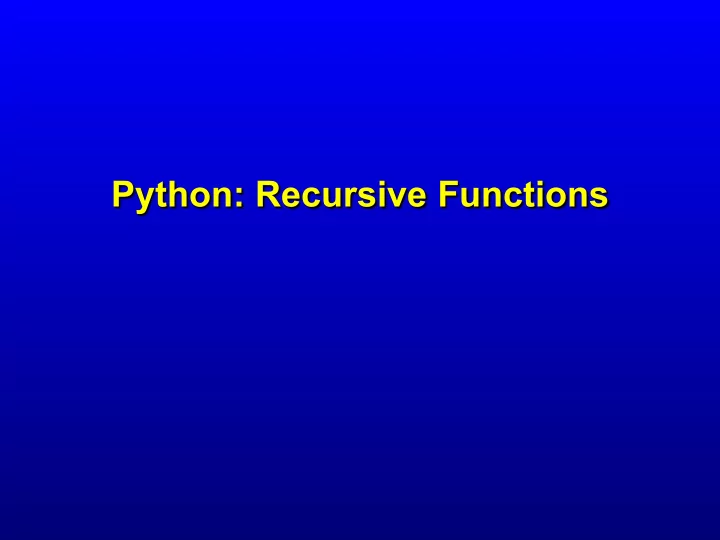

Python: Recursive Functions
Recursive Functions Recall factorial function: Iterative Algorithm Loop construct (while) can capture computation in a set of state variables that update on each iteration through loop
Recursive Functions Alternatively: Consider 5! = 5x4x3x2x1 can be re-written as 5!=5x4! In general n! = nx(n-1)! factorial(n) = n * factorial(n-1)
Recursive Functions Alternatively: Consider Recursive Algorithm 5! = 5x4x3x2x1 can be re-written as 5!=5x4! function calling itself In general n! = nx(n-1)! factorial(n) = n * factorial(n-1)
Recursive Functions
Recursive Functions Known Base case
Recursive Functions Base case Recursive step
Recursive Functions • No computation in first phase, only function calls • Deferred/Postponed fact (4) 4 * fact (3) computation 4 * (3 * fact (2)) 4 * (3 * (2 * fact (1))) – after function calls 4 * (3 * (2 * (1 * fact (0)))) terminate, computation 4 * (3 * (2 * (1 * 1))) 4 * (3 * (2 * 1)) starts 4 * (3 * 2) • Sequence of calls have 4 * 6 24 to be remembered Execution trace for n = 4 Courtesy Prof PR Panda CSE Department IIT Dehi
Another Example (Iterative) Iterative Source:https://ocw.mit.edu/courses/electrical-engineering-and-computer-science/6-0001-introduction-to-computer-science-and- programming-in-python-fall-2016/lecture-slides-code/
Another Example (Recursive) Iterative Algorithm Recursive Source:https://ocw.mit.edu/courses/electrical-engineering-and-computer-science/6-0001-introduction-to-computer-science-and- programming-in-python-fall-2016/lecture-slides-code/
Recursive Functions • Size of the problem reduces at each step • The nature of the problem remains the same • There must be at least one terminating condition • Simpler, more intuitive – For inductively defined computation, recursive algorithm may be natural • close to mathematical specification • Easy from programing point of view • May not efficient computation point of view
GCD Algorithm b if a mod b = 0 gcd (a, b) = gcd (b, a mod b) otherwise Iterative Recursive Algorithm Algorithm
GCD Algorithm b if a mod b = 0 gcd (a, b) = gcd (b, a mod b) otherwise gcd (6, 10) gcd (10, 6) gcd (6, 4) gcd (4, 2) 2 2 2 2 Courtesy Prof PR Panda CSE Department IIT Dehi
Fibonacci Numbers 0 n = 1 fib (n) = 1 n = 2 fib (n-1) + fib (n-2) n > 2 Recursive Algorithm Courtesy Prof PR Panda CSE Department IIT Dehi
Fibonacci Numbers fib (6) fib (5) fib (4) fib (4) fib (3) fib (3) fib (2) fib (3) fib (2) fib (2) fib (1) fib (2) fib (1) fib (2) fib (1) Courtesy Prof PR Panda CSE Department IIT Dehi
Power Function • Write a function power (x,n) to compute the n th power of x 1 if n = 0 power(x,n) = x * power(x,n-1) otherwise
Power Function • Efficient power function • Fast Power – fpower(x,n) = 1 for n = 0 – fpower(x,n) = x * (fpower(x, n/2)) 2 if n is odd – fpower(x,n) = (fpower(x, n/2)) 2 if n is even
Power Function • Efficient power function
Towers of Hanoi Problem • 64 gold discs with different diameters • Three poles: ( Origin, Spare, Final) • Transfer all discs to final pole from origin – one at a time – spare can be used to temporarily store discs Origin Spare Final – no disk should be placed on a smaller disk • Intial Arrangement: – all on origin pole, largest at bottom, next above it, etc. Courtesy Prof PR Panda CSE Department IIT Dehi
3-Step Strategy Origin Spare Origin Spare Final Final Solve for (n-1) disks. Move to Spare. Use Final as Spare. Origin Spare Origin Spare Final Final Move (n-1) disks to Final. Move bottom disk to Final Use Origin as Spare. Courtesy Prof PR Panda CSE Department IIT Dehi
Recursive Solution • Use algorithm for (n-1) disks to solve n-disk problem • Use algorithm for (n-2) disks to solve (n-1) disk problem • Use algorithm for (n-3) disks to solve (n-2) disk problem • ... • Finally, solve 1-disk problem: – Just move the disk! Courtesy Prof PR Panda CSE Department IIT Dehi
Recursive Solution Source:https://ocw.mit.edu/courses/electrical-engineering-and-computer-science/6-0001-introduction-to-computer-science-and- programming-in-python-fall-2016/lecture-slides-code/
Recommend
More recommend